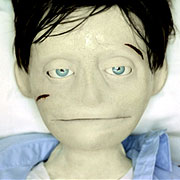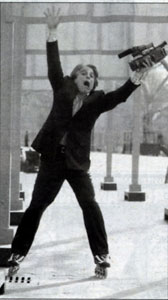The BFI’s National Film Theatre is running a complete Tarkovsky retrospective through March 30. It includes new prints of both Solaris and Stalker. And who can pass up seeing Andrei Rublev on the big screen? [I know everyone in NYC passed up seeing it on video; I bought an utterly unused copy, fresh from the newly dead Kozmo.com, on ebay a few years back.]
NFT: Andrei Tarkovsky [bfi.org.uk, via kultureflash]
Author: greg
Read What I Read, Not What I Write
Poss. alt. title: greg.org reads the NYT to you.
If you have to tell someone to be cool…
it’s already too late, they’re not. If only the movie were as well done as Mahnola Dargis’s review.
added bonus: NYTimes.com, HTML hand-coded, just for you: “,em>This film is rated PG-13”
Manohla Dargis’s review of Be Cool [nyt]
On Demand
 The other night Thomas Demand offhandedly described some of the insane details of the production of Clearing, the massive photograph of a forest which is now built into The Modern at MoMA. The photograph was laminated onto two sheets of architectural safety glass that were so large, they had to use satellite-curing ovens at ESA, the European Space Agency–at night–to fabricate it. When the request for the work, Thomas said, “no one quite knew what they were getting.”
The other night Thomas Demand offhandedly described some of the insane details of the production of Clearing, the massive photograph of a forest which is now built into The Modern at MoMA. The photograph was laminated onto two sheets of architectural safety glass that were so large, they had to use satellite-curing ovens at ESA, the European Space Agency–at night–to fabricate it. When the request for the work, Thomas said, “no one quite knew what they were getting.”
[On an irrelevant note, the lifesize set for Clearing happened to be in Demand’s studio during a MoMA Jr Associates visit I set up. It was so stunning, the trustees quickly added the studio to their Berlin itinerary, and curator Kynaston McShine suggested the Modern acquire the work. And I still can’t get a reservation.]
I mention this–obviously I mention the studio story for self-aggrandizement, but remember the tagline of this site, yo–because not quite knowing what you’re getting seems like one of the underlying currents of Demand’s work.
Walking through the show, I tried to recall the portentous actual setting that was obscured behind each photograph’s generic title: Kitchen was Saddam’s, Archive was Riefenstahl’s, etc., but I kept remembering them wrong, which made me load all kinds of historical baggage onto each image; turns out only some of the bags actually matched. Barn was Pollock’s, not Kaczynski’s; the cluttered desk was L. Ron Hubbard’s, not Bill Gates’. The Bauhaus-style stairway was from Demand’s middle school, but it turns out even he remembered it wrong.
Thomas Demand opens today at MoMA [moma.org]
Michael Kimmelman calls it “hypnotic” [nyt]
No one goes to The Modern; it’s too crowded
I’m Your Puppet
 Interpol’s video for “Evil” from their recent album “Antic” was directed by the artist/CG animator Charlie White. It features an Interpol-ish puppet–“pale, thin, with dark hair and a boyish-man quality”–that looks like White’s trademark alien/troll figures in human drag.
Interpol’s video for “Evil” from their recent album “Antic” was directed by the artist/CG animator Charlie White. It features an Interpol-ish puppet–“pale, thin, with dark hair and a boyish-man quality”–that looks like White’s trademark alien/troll figures in human drag.
MTV.com has some press junket-level technical details of the making of.
Interpol’s ‘Evil’ Is More Like ‘Creepy’ [mtv.com, via fimoculous]
Previously: greg.org on Interpol
This is your brain on Gehry. Any Questions?
Since it was opened, the polished stainless steel roof on Frank Gehry’s Disney Concert Hall in LA has been throwing off so much glare, people are getting baked alive in the neighboring condominiums. And on the street, fuggedaboutit. They’re frying eggs and dog’s brains on the sidewalk.
The result: the County Board of Supervisors has ordered a bunch of workers with hand sanders to climb up there and dull the thing down a bit. Meanwhile, some tourist from New Jersey, 3,000 miles away, thinks they should leave it alone.
Disney Concert Hall to lose some luster [LAT, via BoingBoing]
Related: Frank Lloyd Wright’s Ennis-Brown house was “red-tagged,” meaning no one can enter it, after a inspectors noticed a rainsoaking-related shift in a retaining wall. [LAT, via archinect]
Edited For Content
So we finally caught Sideways, twice, on the plane back from Amsterdam. The fat white trash sex scene was edited out, of course, and the PG dubbing was awkward [how can they not say “get you laid”? It’s the characters’ whole point.] with one exception: they replaced “a**hole” with “Ashcroft” which, at least in the first occurrence, just sounded like Oscar-worthy writing.
Meanwhile, on the other channel, Alfie was so full of humping, naked birds and profanity, it would’ve been outrageously offensive–if anyone could’ve been bothered to watch it.
[update: Slate linked to this Thursday WashPost report of the Ashcroft thing. Airline movies run for a month, but presumably, it didn’t raise any eyebrows until now.]
2005-03-07, This Week In The New Yorker
![]()
Issue of 2005-03-07
Posted 2004-02-28
THE TALK OF THE TOWN
COMMENT/ BELIEVER/ Louis Menand on the life and death of Hunter S. Thompson.
ON TOUR/ DR. JUICE/ Ben McGrath attends a Jose Canseco book signing.
AWARDS SEASON/ THE POLLIES/ Adam Green on a proud night for political consultants.
GIZMOS/ TWO PENS/ Tad Friend on recent advances in ink dispensation.
SUMATRA POSTCARD/ OUR MAN IN MEDAN/ Dan Baum meets an American diplomat in post-tsunami Sumatra.
THE POLITICAL SCENE/ Jeffrey Toobin/ Blowing Up the Senate/ Extreme tactics in the fight to confirm judges.
FICTION/ Umberto Eco/ “The Gorge”
THE BACK PAGE/ Paul Rudnick/ “Further Proof That Lincoln Was Gay”
THE CRITICS
BOOKS/ Adam Gopnik/ Voltaire’s Garden/ The philosopher as a campaigner for human rights.
ON TELEVISION/ Nancy Franklin/ Vision Quest/ The mind of the married medium.
THE ART WORLD/ Peter Schjeldahl/ Drawing Lines/ Cy Twombly at the Whitney.
POP MUSIC/ Sasha Frere-Jones/ Ring My Bell/ The expensive pleasures of the ringtone.
THE CURRENT CINEMA/ David Denby/ Devilment/ “Be Cool,” “Constantine.”
FROM THE ARCHIVE
LETTER FROM WASHINGTON/ Richard H. Rovere/ January 8, 1959/ A description of the political maneuverings surrounding a filibuster against civil-rights legislation./ Issue of 1959-01-17
Subscribe to the New Yorker via Amazon
Tony Danza: A Tape I WANT To See

So while he is taping himself for “his talk show on skates,” Tony Danza runs into The Gates and falls flat on his face. I don’t know how to unpack this little gem of a story, though:
Tony Danza Crash photo sequence [via Forward Retreat]
Sony VX2100 Buy a [new] Sony VX2100 at Amazon for $2,349.88 [amazon]
The Tony Danza Show [why? and why do they still use go.com? go.com]
The Independent Sideways Awards, &c.
Holy smokes, the IFP awards were a total dogpile on Sideways. I can’t remember all my votes, but even though I’m a Payne/Taylor fan, I spread the love around a little bit more.
Yeah, and on that Oscar, too. We just flew back from Amsterdam, and not just our arms are tired. I was banished from the (TV-equipped) bedroom, so I “watched” the Academy Awards on Gothamist and Defamer [who got the NYT to sponsor their 10-month anniversary party, complete with a gift, um, sac from Fred Durst, you know, the one on Rodeo?]
20th IFP Independent Spirit Awards Winners [ifp.org]
How Bambi Fought The Viet Cong
The story of Donnie Dunagan, the child actor who was the voice of Bambi and went on to fight in Vietnam and to lose his most of his savings in the Enron collapse.
I’m a kottke.org micropatron. Are you?
NFS: Art You Can’t Buy
 Tangentially related to both preparations for my upcoming talks on the art market in Rotterdam and to The Gates being rather showily not for sale, I’ve been thinking about art you can’t buy or sell.
Tangentially related to both preparations for my upcoming talks on the art market in Rotterdam and to The Gates being rather showily not for sale, I’ve been thinking about art you can’t buy or sell.
The Times of London has Tyson’s full puzzle [timesonline.co.uk]
I’m Speaking In Rotterdam This Week
Shameless plug first: I’m speaking and participating in two panel discussions at Art Rotterdam this week. Thursday at 2000 hours [when is that? someone please tell me.] I’m talking about the effects on art and artists of the art market’s global dynamic. That’s at Het Wilde Weten, an alternative art space in Rotterdam, where the other panelists include: artists Jeanne van Heeswijk and Joep van Lieshout; Mondriaan Foundation director Gitta Luiten; journalist Marc Spiegler; and Amsterdam gallery owner Maurice van Valen.
Then on Friday afternoon at 1500 hours, I’m on a panel about private funding of art and museums. The other folks are Peggy Guggenheim Collection’s special events officer Claudia Rech; Rainald Schumacher, Director Goetz Sammlung; Kees van Twist, Director Groningermuseum; and
Frank Lubbers, deputy-director Van Abbemuseum, Eindhoven. The moderator is Prof. Dr. Arjo Klamer of Erasmus University.
Now Available: Apprentice of Nothing T-shirts
 I just made myself a little batch of “apprentice of nothing” t-shirts, which should be here in about 10 days. I’m taking a couple,
I just made myself a little batch of “apprentice of nothing” t-shirts, which should be here in about 10 days. I’m taking a couple, and the rest are available–first come, first served–for $20, domestic shipping included. [mon. night update: they’re gone.] They’re American Apparel superfine jersey, not fitted (L, XL) and come in just one style: white text screened on saffron.
[limited edition apprentice of nothing t-shirt]
[update: in the spirit of transparency, I thought it best to lay out the budget and revenue projections for MY saffron-colored project:
Printer: Customink.com [highly recommended]
Batch size: 12 shirts
Total unit cost: $13.75
Shipping expense: free for standard delivery
Total cost: $165.00
Unit sales price: $20
Gross margin: $6.25
(less postage) $1.85
(less envelopes) $0.50
Unit contribution: $3.85
Total units available for sale: 10
Total contribution: $38.50
(less cost of 2 shirts): $27.50
Project Operating Profit: $11.00
(less design expense, $450/hr): $900
(less managment expense, $$900/hr): $1,800
Net profit (loss): ($2,689)
You’re welcome.
